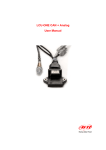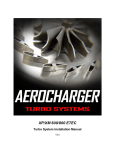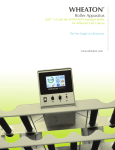Download M-2 Air/Fuel Ratio Meter USER`S MANUAL
Transcript
A and T Labs M-2 Air/Fuel Ratio Meter User’s Manual M-2 Air/Fuel Ratio Meter USER’S MANUAL A and T Labs Inc. P.O. Box 4884 Wheaton, IL 60187 Tel: 630-668-7870 Fax: 630-668-7870 Web: www.a-and-t-labs.com Technical Support: [email protected] 1 2 A and T Labs M-2 Air/Fuel Ratio Meter User’s Manual 1. Introduction The M-2 Air/Fuel ratio meter is a wideband design that provides accuracy and response speed not available from less expensive, narrow band designs. The M-2 achieves this performance with a precision sensor that is temperature compensated. The unit accurately displays air/fuel ratio both on the rich and on the lean side, enabling accurate performance tuning, and not just rich vs. lean. Additionally, the red/green bar graph display is an ideal indicator that allows determination of stoichiometric mixture at a glance, as well as specific mixture. 2. Installing the sensor The sensor has a common 18 x 1.5 mm thread base, and can be mounted in the exhaust system for the convenience of the user. This should, however, preferably be within about 24” of the engine and at a point that combines at least half the cylinders. For tuning purposes, this should clearly be ahead of any catalytic converter. On V-type engines, measurement on one bank is acceptable. A simple method is to drill a hole in a steel exhaust pipe and weld on an 18 x 1.5mm nut, and thread the sensor into the nut. 18mm receptacles are also available from many automotive parts suppliers. Run cable to M-2 meter, making sure it is kept off exhaust and moving components, and protected from vibration. Plug 12 volt cigarette lighter adapter in, and the unit should power up, as indicated on the bottom display light. Be sure to disconnect power after use to keep from draining the battery on cars with non-switched cigarette lighters. On automobile engines, be sure to use only unleaded gasoline. Leaded gasoline will damage the sensor and yield incorrect readings. On aircraft engines, low lead aviation fuel may be used, but will shorten the life of the sensor. 3. Using the M-2 Air/Fuel Ratio Meter After connections are made, turn on the ignition, without starting the engine. After about 20 seconds and the completion of a self-test, the red LEDs should be lit, indicating full-lean. Press and hold the “Test” button for about ten seconds, and observe the two bottom LED extinguishing, indicating the passage of the full-lean test. (After engine operation and shut-down, this test may extinguish only one LED due to residual combustion products in the exhaust system.) Start the engine and perform operational tests as desired. The instrument will show some number of red or green LEDs, red being lean, and green being rich. Theoretically, the ideal mixture at which the number of oxygen molecules available is exactly the right number for complete and perfect combustion of gasoline is 14.7/1, also known as the “stoichiometric” mixture. This mixture works well at low power levels, say from idle to 25% power. At higher power levels, higher fuel/air mixtures are desired. The “best-power” mixture is typically about 12.5/1. In addition to improving power, richer mixtures reduce exhaust temperature, reduce the risk of early ignition (detonation or “pinging”) and improve exhaust valve life. Lean conditions in automobile engines are generally detrimental, except under intermittent overrun conditions. Excessively rich operation is generally not damaging, but lowers economy and can contribute to spark plug fouling. A and T Labs M-2 Air/Fuel Ratio Meter User’s Manual 4. Maintenance No general unit maintenance is required. Exercise appropriate care to avoid damage to cables and connectors. The normal life expectancy of the sensor is in excess of 1000 hours of operation. 3








